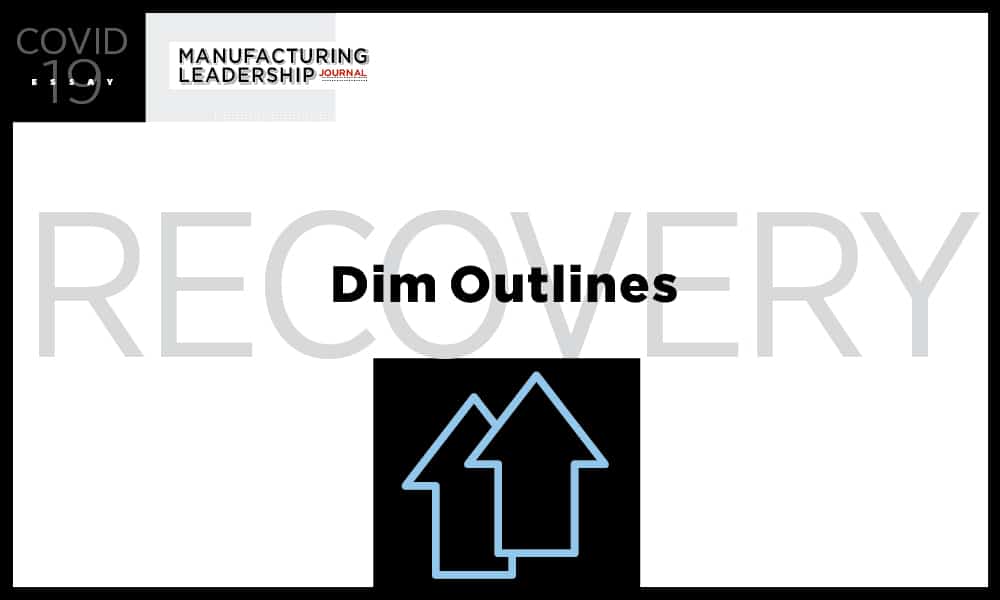
Recovery is coming for manufacturers, but there will never be the same normal.
In the aftermath from the Great Recession of 2008-09, manufacturing was the leader on the path toward U.S. economic recovery. At that time, lower energy prices, high labor productivity, and volatility in international supply chains made the United States a favorable location for manufacturing goods. Durable goods manufacturing returned to its pre-recession output peak in the first quarter of 2013, well ahead of other sectors, and it took the overall economy until 2018 to meet its pre-recession potential GDP, according to the Federal Reserve.
The major question with this recovery is the type of normal to which the industry can return. While post-2009 manufacturers may have found themselves having to overhaul their financial or business models, they weren’t left with also having to do things like procure thousands or even millions of face masks for their employees, or install plexiglass shields between workstations, or suddenly switch to a virtual workforce with little time to prepare.
Manufacturing Leadership Council members have shared about some of these changes. It’s been big things like leave policies, with Amway providing workers with overtime and additional comp pay in the early weeks of the outbreak and temporarily suspending its leave policies. It’s smaller things, like General Motors blocking off chairs in meeting spaces and coaching its employees on the safe use of shop floor fans to prevent virus spread. It’s meant staggering shift start times and rotating breaks. Just about everywhere, employees are required to wear face masks, and a lot of them are subject to a temperature screening when they show up for work.
9/11 was the last major event that ushered in radical change to many aspects of our day-to-day life. Now we accept as normal that we go through a full-body scan before we get on an airplane, and that we can no longer meet our loved ones at the gate. We find security checkpoints at places like the art museum or the amusement park or at the entrance to a baseball game. We submit more documentation to obtain things like drivers’ licenses and passports. We seldom question any of this; it has become normal. What stays with us beyond the pandemic is yet to be seen.
In their factories and throughout their entire supply chains, manufacturers are discovering their own operational new normal. While worker safety has long been a business critical priority for manufacturers, it has expanded from the interface between employees and equipment to now encompass interactions between employees and other employees. Considerations for pathogen transmission, once reserved for healthcare and other sanitation-sensitive settings, have now moved into all areas of the factory, not just the clean rooms and labs.

It’s the industry’s tried and true values that lie at the heart of this recovery — resilience, the desire to find better solutions, the ability to adapt.
It also means tradeoffs. Bradley Rick, Director of Manufacturing at Amway, says his company has implemented staff and equipment grids to limit interactions between employees. While it’s been effective for minimizing the impact of potential infections, it has also limited production and the agility that is usually afforded through Amway’s skills-based team strategy. “It prevents the flow of people to work, which can limit our flexibility in production scheduling.”
Rick says their new focus is how to safely return employees who have been working remotely without disrupting the practices that essential employees have assimilated. “We are assessing the necessity of certain supply chain functions to work on campus, like planning and procurement, since many of those employees have been very effective working at home.”
Indeed, the future is likely to be one of a hybrid virtual and physical organization. “If there has been any light in this, it might be that we’ve discovered our ability to work in a more virtual world,” said Doug Carson, Assistant President and Director – Business and Product Development at BWI Group, an automotive supplier. But it’s not just for strictly back-office jobs. “We’ve had at least one customer ask that we investigate VR technology so they could perform site evaluations remotely.”
While remote shop floor operation is nothing new, the pandemic has given manufacturers the onus to accelerate and prioritize its uses. Operational activities like equipment service, verification, inspection, and monitoring are more often getting done remotely, making companies reconsider how often they need to send employees to outside facilities. “It is likely we will see a reduced level of travel which is, by definition, non-value added,” Carson said. That means even after travel restrictions have lifted, the engineer accustomed to getting on a long flight to visit a customer facility may now find themselves doing much of that work virtually.
But while it might be advanced technologies that will be manufacturing’s means of revival, it’s really the industry’s tried and true values that lie at the heart of this recovery – resilience, the desire to find better solutions, the ability to adapt. “In the end, events like these should make the entire enterprise stronger,” Carson said. “That might be the biggest benefit of all.” M